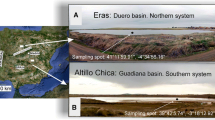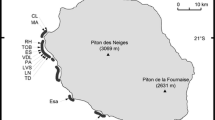Abstract
Arctic lakes, ponds and streams contain benthic microbial mats that are dominated by cyanobacteria, and these communities often account for a large proportion of the total ecosystem biomass and productivity. The vertical structure and composition of mats from two different aquatic habitats in the Canadian High Arctic, Ward Hunt Lake and a polar desert stream were analyzed in detail by microscopy techniques. Two distinct layers were identified in each mat: a surface layer with a high density of cells and associated extracellular polymeric substances (EPS), and a less cohesive bottom layer with an accumulation of mineral particles. The matrix formed by the cyanobacterial filaments and EPS produced the complex microstructure of all three mats, and likely favoured different microenvironments where specialized microbial interactions and biomineralization processes could take place. Structural and compositional differences were found among the mats. The lake mat had a surface layer of Dichothrix, and contained abundant particles of calcium carbonate, while Tychonema-like and Tolypothrix-like appeared mainly in the stream mats, along with a higher diversity of Chroococcales. A black microbial mat from one of the stream sites had markedly lower diversity than the other mat types. The observed differences in cyanobacterial composition and physical structure may be related to habitat stability and the availability of liquid water.











Similar content being viewed by others
References
Bonilla S, Villeneuve V, Vincent WF (2005) Benthic and planktonic algal communities in a high arctic lake: pigment structure and contrasting responses to nutrient enrichment. J Phycol 41:1120–1130
Bontognali TRR, Vasconcelos C, Warthmann RJ, Bernasconi SM, Dupraz C, Strohmenger CJ, McKenzie J (2010) Dolomite formation within microbial mats in the coastal sabkha of Abu Dhabi (United Arab Emirates). Sedimentology 57:824–844
Braissant O, Decho AW, Dupraz C, Glunk C, Przekop KM, Visscher PT (2007) Exopolymeric substances of sulfate-reducing bacteria: interactions with calcium at alkaline pH and implication for formation of carbonate minerals. Geobiology 5:401–411
Braissant O, Decho AW, Prezekop KM, Gallagher K, Glunk C, Dupraz C, Visscher P (2009) Characteristics and turnover of exopolymeric substances in a hypersaline microbial mat. FEMS Microbiol Ecol 67:293–307
Chan C (2004) Microbial polysaccharides template assembly of nanocrystal fibers. Science 303:1656–1658
Comte K, Sabacka M, Carre-Mlouka A, Elster J, Komarek J (2007) Relationships between the Arctic and Antarctic cyanobacteria: three Phormidium-like strains evaluated by a polyphasic approach. FEMS Microbiol Ecol 59:366–376
De los Ríos A, Ascaso C, Wierzchos J, Fernandez-Valiente E, Quesada A (2004) Microstructural characterization of cyanobacterial mats from the McMurdo Ice Shelf, Antarctica. Appl Environ Microbiol 70:569–580
De los Ríos A, Cary C, Cowan D (2014a) The spatial structures of hypolithic communities in the Dry Valleys of East Antarctica. Polar Biol 37:1823–1833
De los Ríos A, Wierzchos J, Ascaso C (2014b) The lithic microbial ecosystems of Antarctica’s McMurdo dry valleys. Antarct Sci 26:459–477
De Maayer P, Anderson D, Cary C, Cowan DA (2014) Some like it cold: understanding the survival strategies of psychrophiles. EMBO Rep 15:508–517
Decho AW (2000) Exopolymer microdomains as a structuring agent for heterogeneity within microbial biofilms. In: Riding RE, Awramik SM (eds) Exopolymer microdomains as a structuring agent for heterogeneity within microbial biofilms. Springer, Berlin, pp 9–15
Dupraz C, Visscher PT, Baumgartner LK, Reid RP (2004) Microbe-mineral interactions: early carbonate precipitation in a hypersaline lake (Eleuthera Island, Bahamas). Sedimentology 51:745–765
Dupraz C, Reid R, Braissant O, Decho AW, Norman RS, Visscher P (2009) Processes of carbonate precipitation in modern microbial mats. Earth Sci Rev 96:141–162
Fernández-Valiente E, Camacho A, Rochera C, Rico E, Vincent WF, Quesada A (2007) Community structure and physiological characterization of microbial mats in Byers Peninsula, Livingston Island (South Shetland Islands, Antarctica). FEMS Microbiol Ecol 59:377–385
Glunk C, Dupraz C, Braissant O, Gallagher K, Verrecchia E, Visscher P (2011) Microbially mediated carbonate precipitation in a hypersaline lake, Big Pond (Eleuthera, Bahamas). Sedimentology 58:720–738
Hawes I, Sumner D, Andersen D, Jungblut A, Mackey T (2013) Timescales of growth response of microbial mats to environmental change in an ice-covered Antarctic lake. Biology 2:151–176
Jungblut AD, Hawes I, Mountfort D, Hitzfeld B, Dietrich DR, Burns BP, Neilan BA (2005) Diversity within cyanobacterial mat communities in variable salinity meltwater ponds of McMurdo Ice Shelf, Antarctica. Environ Microbiol 7:519–529
Jungblut AD, Lovejoy C, Vincent WF (2010) Global distribution of cyanobacterial ecotypes in the cold biosphere. ISME J 4:191–202
Komárek J, Anagnostidis K (1989) Modern approach to the classification system of Cyanophytes, 4–Nostocales. Arch Hydrobiol Suppl. 82/Algol Stud 56:247–345
Komárek J, Anagnostidis, K. (1999) Cyanoprokaryota. 1. Chroococcales. In: Ettl H, Gärtner G, Heynig H, Mollenhauer D (eds) Süßwasserflora von Mitteleuropa. Begründet von A. Pascher. Band 19/1. Spektrum, Akademischer Verlag, Heidelberg, pp 1–548
Komárek J, Anagnostidis K (2005) Cyanoprokaryota. 2. Teil: Oscillatoriales. In: Büdel B, Gärdner G, Krienitz L, Schagerl M. (eds) Süsswasserflora von Mitteleuropa, vol. 19/2. Elsevier, München
Krembs C, Eicken H, Junge K, Deming JW (2002) High concentrations of exopolymeric substances in Arctic winter sea ice: implications for the polar ocean carbon cycle and cryoprotection of diatoms. Deep Sea Res Part I 49:2163–2181
Lionard M, Péquin B, Lovejoy C, Vincent WF (2012) Benthic cyanobacterial mats in the High Arctic: multi-layer structure and fluorescence responses to osmotic stress. Front Microbiol 3:140
Loza V, Perona E, Carmona J, Mateo P (2013) Phenotypic and genotypic characteristics of Phormidium-like cyanobacteria inhabiting microbial mats are correlated with the trophic status of running water. Eur J Phycol 48:235–252
Nichols C, Guezennec J, Bowman J (2005) Bacterial exopolysaccharides from extreme marine environments with special consideration of the southern ocean, sea ice, and deep-sea hydrothermal vents: a review. Mar Biotechnol 7:253–271
Noffke N, Gerdes G, Klenke T (2003) Benthic cyanobacteria and their influence on the sedimentary dynamics of peritidal depositional systems (siliciclastic, evaporitic salty, and evaporitic carbonatic). Earth Sci Rev 62:163–176
Paerl HW, Pinckney JL (1996) A mini-review of microbial consortia: their roles in aquatic production and biogeochemical cycling. Microb Ecol 31:225–247
Peeters K, Verleyen E, Hodgson D, Convey P, Ertz D, Vyverman W, Willems A (2012) Heterotrophic bacterial diversity in aquatic microbial mat communities from Antarctica. Polar Biol 35:543–554
Petroff AP, Sim MS, Maslov A, Krupenin M, Rothman DH, Bosak T (2010) Biophysical basis for the geometry of conical stromatolites. Proc Nat Acad Sci 107:9956–9961
Quesada A, Vincent WF (2012) Cyanobacteria in the cryosphere: snow, ice and extreme cold. In: Whitton BA (ed) Ecology of Cyanobacteria II. Springer, New York, pp 387–399
Quesada A, Vincent WF, Lean DRS (1999) Community and pigment structure of arctic cyanobacterial assemblages: the occurrence and distribution of UV-absorbing compounds. FEMS Microb Ecol 28:315–323
Quesada A, Sanchez-Contreras M, Fernández-Valiente E (2001) Tolerance of Antarctic cyanobacterial microbial mats to natural UV radiation. Nova Hedwigia 123:275–290
Singh SM, Elster J (2007) Cyanobacteria in Antarctic lake environments: a mini-review. In: Seckbach J (ed) Algae and cyanobacteria in extreme environments. Springer, Dordrecht, pp 303–320
Taton A, Hoffmann L, Wilmotte A (2008) Cyanobacteria in microbial mats of Antarctic lakes (East Antarctica)—a microscopical approach. Algol Stud 126:173–208
Tolker-Nielsen T, Molin S (2000) Spatial organization of microbial biofilm communities. Microb Ecol 40:75–84
Tytgat B, Verleyen E, Obbels D, Peeters K, De Wever A, D’hondt S, De Meyer T, Van Criekinge W, Vyverman W, Willems A (2014) Bacterial diversity assessment in Antarctic terrestrial and aquatic microbial mats: a comparison between bidirectional pyrosequencing and cultivation. PLoS One 9:e97564. doi:10.91371/journal.pone.0097564
Van Hove P, Vincent WF, Galand PE, Wilmotte A (2008) Abundance and diversity of picocyanobacteria in high arctic lakes and fjords. Algo Stud 126:209–227
Varin T, Lovejoy C, Jungblut A, Vincent WF, Corbeil J (2010) Metagenomic profiling of Arctic microbial mat communities as nutrient scavenging and recycling systems. Limnol Oceanogr 55:1901–1911
Varin T, Lovejoy C, Jungblut A, Vincent WF, Corbeil J (2012) Metagenomic analysis of stress genes in microbial mat communities from Antarctica and the High Arctic. Appl Environ Microbiol 78:549–559
Verleyen E, Sabbe K, Hodgson DA, Grubisic S, Taton A, Cousin S, Wilmotte A, De Wever A, Van Der Gucht K, Vyverman W (2010) Structuring effects of climate-related environmental factors on Antarctic microbial mat communities. Aquat Microb Ecol 59:11–24
Vézina S, Vincent WF (1997) Arctic cyanobacteria and limnological properties of their environment: Bylot Island, Nothwest Territories, Canada (73ºN, 80ºW). Polar Biol 17:523–534
Villeneuve V, Vincent WF, Komárek J (2001) Community structure and microhabitat characteristics of cyanobacterial mats in an extreme high Arctic environment: Ward Hunt Lake. Nova Hedwigia 123:199–224
Vincent WF (1988) Microbial ecosystems of Antarctica. Cambridge University Press, Cambridge
Vincent WF, Quesada A (2012) Cyanobacteria in high latitude lakes, rivers and seas. In: Whitton BA (ed) Ecology of Cyanobacteria II. Springer, New York, pp 371–385
Vincent WF, Castenholz RW, Downes MT, Howard-Williams C (1993) Antarctic cyanobacteria: light, nutrients, and photosynthesis in the microbial mat environment. J Phycol 29:745–755
Vincent WF, Gibson JAE, Pienitz R, Villenueve V (2000) Ice shelf microbial ecosystems in the High Arctic and implications for life on snowball Earth. Naturwissenschaften 87:137–141
Vyverman W, Verleyen E, Wilmotte A, Hodgson D, Willems A, Peeters K, Van de Vijver B, De Wever A, Leliaert F, Sabbe K (2010) Evidence for widespread endemism among Antarctic micro-organisms. Polar Sci 4:103–113
Acknowledgments
We are grateful to PCPS for the logistic support to the High Arctic and Parks Canada for access to their facilities in Quttinirpaaq National Park. This project was funded by the Grants REN2000-0435, CGL2005-06549, POL2006-06635 and CTM2011-28736 from Spanish Ministry of Economy and Competitiveness, with funding of the microscopy studies through grants CTM2012-38222-C02-02 and CGL2013-42509. Additional support was provided by the Natural Sciences and Engineering Research Council of Canada and the Canada Research Chair program. The authors would like to thank to ICA and the MNCN (CSIC) microscopy services staff for technical assistance.
Author information
Authors and Affiliations
Corresponding author
Additional information
Communicated by Anurag chaurasia.
Rights and permissions
About this article
Cite this article
de los Ríos, A., Ascaso, C., Wierzchos, J. et al. Microstructure and cyanobacterial composition of microbial mats from the High Arctic. Biodivers Conserv 24, 841–863 (2015). https://doi.org/10.1007/s10531-015-0907-7
Received:
Revised:
Accepted:
Published:
Issue Date:
DOI: https://doi.org/10.1007/s10531-015-0907-7




